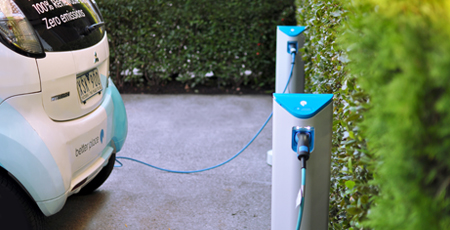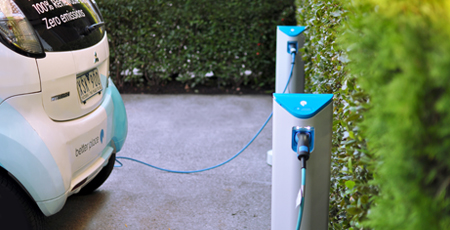Eco-friendly cars have been growing in popularity, as the effects of global warming continue to make headlines all over the world. Manufacturers of green cars are constantly trying to improve the functionality of electric and hybrid cars with the aim of eventually replacing the conventional automobile with zero carbon emission models.
There are a variety of green cars currently available on the market, some of which are greener while others are more practical. The two proceeding types of green car are debatably the most popular, though other green fuel options such as bio-fuels, LPG and hydrogen fuel cells are available alternatives.
Electric Cars
Electric cars can be zero-emission vehicles and are arguably the most eco-friendly form of automobile. They can function without the burning of fossil fuels if solar or wind power is used to generate the electricity that charges their batteries. Using such renewable energy sources could replace petrol/diesel cars with electric cars which would also dramatically improve air quality.
 The cars run on an electric motor which is battery operated and requires regular charging. Currently, public charging points are located rather sparsely – although it is possible to have a charging point installed in the home.
The cars run on an electric motor which is battery operated and requires regular charging. Currently, public charging points are located rather sparsely – although it is possible to have a charging point installed in the home.
Manufacturers are hoping that a growth in popularity of green cars will spark the installation of more public charging points that rely on renewable energy sources for their power. In Australia, Better Place is currently installing charging points around the country, with the intention of building the world’s largest electric car charge network by the end of 2013.
Electric cars’ limited range and lower maximum speed are largely responsible for their slow growth in popularity. However, unlike the older electric cars, which had a battery range of around 160 km (100 miles) and a maximum speed of around 70 km/hour (45mph), newer electric cars are already improving. The Renault Fluence ZE, for example, has a range of around 185 km and a top speed around 135 km/hour – faster than most people will ever need to drive. Range though, is one of the main future improvement focuses for manufacturers, which when resolved should hopefully give electric cars a popularity boost, whether it is through newer technology or wider charging networks.
Electric cars are an incredibly cost effective means of personal transport. There’s no fuel expense or emissions , but of course, the electricity they use has to come from somewhere. Some environmentalists argue that using electric cars is simply shifting the responsibility of climate change from cars, rather than eliminating the problem, since they rely on electricity, usually provided by the national grid, typically not a carbon emission free source. To combat this problem, manufacturers are assessing the possibility of using renewable energy such as solar power, by installing a network of charging stations which use clean energy sources as power, and are therefore zero carbon emitters. The Better Place network in Australia is an example of this.
Hybrid Vehicles
Hybrid cars combine two power sources, typically electricity and petrol/diesel, to power the vehicle. The electric motor powers the car at lower speeds while the fuel provides power for higher speeds. The use of electricity to power the vehicle at lower speeds reduces the amount of fuel consumed, therefore reducing fuel costs and carbon emissions. When the vehicle is travelling at a low speed and relying on the electric motor, it’s a zero-emission vehicle. In the majority of hybrids, the electric motor is recharged by reclaiming energy when the brakes are applied, which is a clean energy source.
Hybrid vehicles are currently more practical for most drivers as their electric power is supplemented by fuel, so they can achieve higher speeds and more importantly, don’t have the limited range of electric cars. The popularity of hybrid vehicles has increased somewhat over the last few years as they’re becoming a cost effective, eco-friendly means of transport. Their main negatives remain, however, that they come with an initially high price tag and still rely heavily on the use of fossil fuels.
Eco-friendly cars have a bright future as our primary means of transport. With environmentalists encouraging the use of renewable energy sources and a reduction in the use of fossil fuels, combining with the rising price of oil, green cars could soon be the most cost effective and environmentally friendly mode of personal transport around.
Stephanie Staszko is a writer who has a great interest in the latest eco-friendly news and view. She writes on behalf of Just Motor Law motoring offence solicitors.




Electric cars are also more expensive than regular cars and some people say if EV’s use electricity that is largely generated from fossil fuels, then how green are they? The goal is to use more alternative fuel to generate the electricity at the power plants.
That’s true Joy, and you’ll see that Stephanie mentions that issue in her article. However, having charging stations that are powered with renewable energy, such as the network Better Place is rolling out in Australia, or having a home charging point powered by (for instance) solar power, alleviates this criticism I think.
Hybrid cars are one of the best options for green cars. They are easy to drive and safe too. You don’t have to worry about the danger you are causing the environment too.
Nice article regarding the Eco-friendly cars. In my point of view, a plug-in hybrid car has advantages over both hybrid and electric vehicle. It emits comparatively less emission than hybrid cars and also has more range of operation than electric vehicle. There are several issues are associated with the use of electric vehicle. Electric vehicle is in it’s initial stage of development and needs more time to over come various disadvantages associated with it.
Hi Avery, thanks for sharing your perspective.